Today’s brake replacement market is not only becoming highly competitive, it’s also becoming very complex. In an effort to reduce overall vehicle weight and improve ride and handling characteristics, brake assemblies have been reduced in size and weight. In addition, late-model vehicles now incorporate anti-lock braking systems (ABS) and vehicle stability controls (VSC) into their brake system designs. While ABS is a relatively old technology, VSC is new in the sense that it uses individual brakes to help stabilize and steer a vehicle in an emergency-handling situation. In short, brakes must work harder than ever, and what this new technology means to the typical import shop is that it’s more important than ever to provide quality brake service at a competitive price.
BRAKE QUALITIES
Years ago, a brake replacement would pass muster if it allowed a vehicle to stop in a reasonable distance at highway speeds. Today, a brake replacement must meet consumer-oriented criteria in areas of braking noise, pedal sensitivity, side-to-side pulling, pedal pulsation, frictional qualities, fade resistance, wheel dusting and friction longevity.
Keep in mind also that, as part of the ABS and VSC systems, the braking system must work perfectly each time these systems are activated. To illustrate, a brake pulling condition might interfere with the VSC function. Similarly, installing different grades of friction on the front and rear axles could reduce ABS system efficiency. Although the effects of poor quality friction materials would be difficult to predict on these systems, it certainly isn’t worth the potential liability if the vehicle was involved in a serious accident because the ABS or VSC responded incorrectly.
CUSTOMER SATISFACTION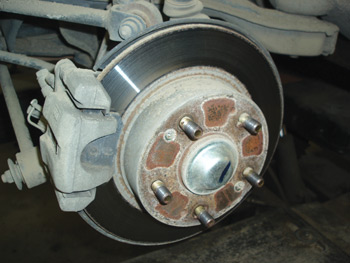
It’s critical in brake service to thoroughly interview the customer and convey his or her concerns to the technician receiving the brake repair order. You can compose your own interview check list, but, in general terms, what does the customer like or not like about his current brakes? Perhaps the pedal isn’t as firm as it should be, or perhaps the brakes aren’t as pedal-sensitive as the customer would like. Perhaps the brakes are noisy in wet weather, or perhaps the pedal effort is too high when towing the family camper trailer. In short, the goal of your brake service should be customer satisfaction and your job is to make your customer happy by installing the appropriate brake friction on his or her vehicle. See Photo 1.
APPLICATION-SPECIFIC BRAKE PADS
The brake pad is the heart of the braking system. If you’re having difficulty keeping your customers happy with your brake repairs, perhaps it’s time to start building a case file covering the types of pads installed on specific vehicle platforms. By interviewing your customers and establishing a brake service file in your shop management system to compare the results, you might discover that Brand “A” brake friction performs better on a specific platform than Brand “B.” Or that procedure “C” delivers fewer noise complaints than service “D.”
In any case, it’s important to recognize that modern technology has delivered a myriad of brake friction materials into the market. While the two-letter Department of Transportation (DOT) edge codes might tell us the general frictional characteristics of a brake friction material, it doesn’t tell us about the braking noise, pedal sensitivity, pedal pulsation, wheel dusting and longevity characteristics of the brake pad. What edge codes do provide is how brake friction performs at 250° F and 600° F operating temperatures. 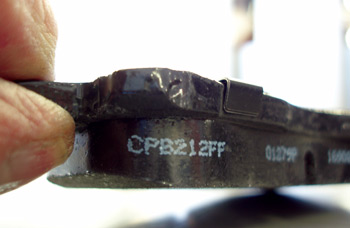
Keeping in mind that the frictional coefficient of steel-to-steel is about 0.25, a premium pad or “FF” pad will generate a frictional coefficient of 0.35 and 0.45 at both temperature extremes with possibly 0-22% fade at 600° F. On the other hand, an FE-rated pad will generate 0.25 at 250° F and 0.35 at 600° F operating temperatures, with possibly 2-44% fade at 600° F. Clearly, the FE pad doesn’t have much pedal sensitivity at lower temperatures. If you want to learn more about edge codes, just type “brake edge codes” into the search function on www.import-car.com. See Photo 2.
Because some friction manufacturers supply pads that address different driving habits and conditions, it’s important to thoroughly understand the options provided by your brake friction supplier. Most aftermarket suppliers offer brake friction that meets the requirements for specific operating conditions. That’s why brake friction suppliers offer a variety of application-specific friction materials that fall into the general categories of ceramic, semi-metallic and organic braking materials. Generally speaking, ceramic is designed to reduce dusting complaints, semi-metallic is used in high-load applications and organic might be used in low-stress driving situations.
But keep in mind that the selection of brake friction compounds is nearly infinite. Competition brake friction manufacturers offer literally dozens of friction blends to meet different driving conditions on both dirt and asphalt. Similarly, modern carbon-fiber blends can easily operate at well over 1,000° F with nearly double the frictional coefficient of conventional compounds. 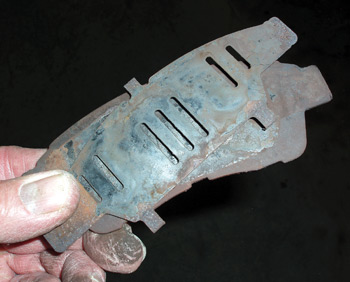
Last, keep in mind that some friction compounds can transfer friction material from the pad to the rotor, causing a difficult-to-diagnose pedal pulsation complaint. Similarly, because some brake caliper designs will boil the brake fluid at high operating temperatures, make sure that a friction compound is compatible with a particular caliper design. See Photo 3.
ROTOR PREPARATION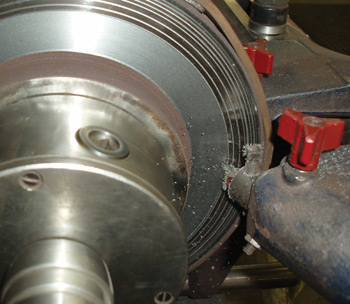
If the brake pad is the heart of the brake, the brake rotor is certainly the foundation. Many modern import shops feel it’s more cost-effective to replace, rather than resurface, disc brake rotors. Yet some shops have found that on-vehicle resurfacing provides the required results. The primary virtue of on-vehicle resurfacing is that it compensates for hub runout during the resurfacing process. Yet, many shops still feel comfortable with off-vehicle resurfacing and, in most cases, that method is entirely satisfactory providing the correct procedures are followed. See Photo 4.
If it’s convenient, check for rotor runout on the vehicle and index the area of maximum runout. Before mounting the rotor on the lathe, it’s always important to clean the hub mounting surface of the rotor with an abrasive pad or disc. The area of maximum runout should correspond with the “scratch test” on the lathe. A clean-up of rust and dirt on the vehicle hub itself should be done before the rotor is re-installed. See Photo 5.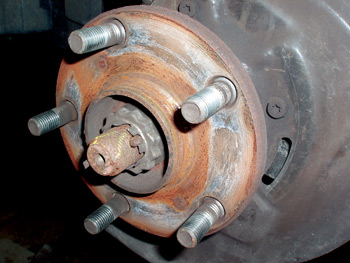
When turning the rotor, use the finest feed for the finished cut. After turning the rotor, sand it with 120-grit sandpaper or an abrasive pad mounted on a rotating arbor. After it’s removed from the lathe, the rotor should be scrubbed in a soap-and-water solution to remove any metallic particles that might embed into the new friction material.
A rule of thumb is that the difference in side-to-side rotor thickness shouldn’t exceed 0.010” on most non-vented rotors. Manufacturers’ tolerances might be higher on vented rotors. As for replacing just one rotor, remember that aftermarket replacement rotors often don’t match the originals in mass, vent sizing, cooling fin configuration or base material. For this reason, consider replacing rotors as a matched pair.
After the new brakes are installed, I highly recommend flushing the old brake fluid from the system to remove accumulated air bubbles and restore the temperature tolerances of the original brake fluid. Following the flushing procedure, the new brake pads should be seated or “burnished” by gently slowing the vehicle a half-dozen times from moderate speeds. These are extra steps, but they go a long way toward providing maximum satisfaction for your paying customer.













